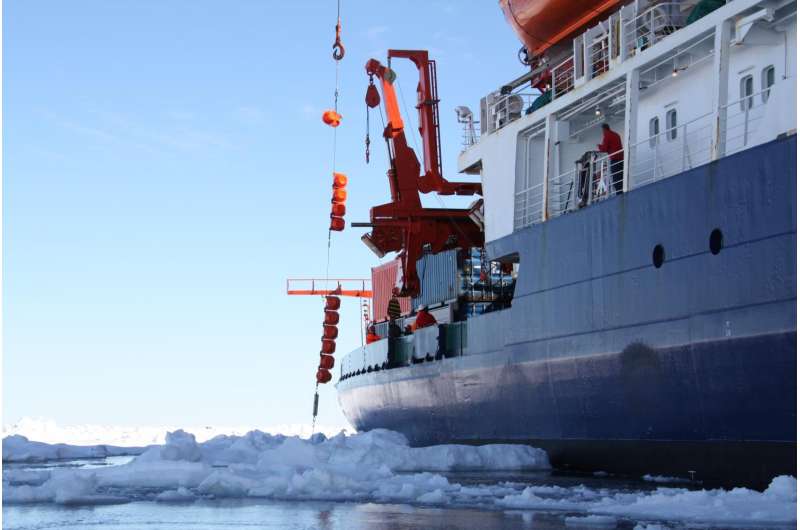Daily up and down of the plankton animals in the sea

A unique series of measurements taken over several years in the Antarctic Ocean provide new findings about the daily vertical migration of zooplankton communities: scientists of the Thünen Institute of Sea Fisheries in Hamburg and the Alfred Wegener Institute in Bremerhaven observed changes during the year and between years. The Antarctic zooplankton is the main source of food for many fish and whale species, including the largest mammal in the world, the blue whale.
For the first time, researchers were able to document the annual cycle of zooplankton communities in the Southern Ocean. Using data from anchored acoustic Doppler current profilers (ADCP), Dr Boris Cisewski of the Thünen Institute of Sea Fisheries and Dr Volker Strass of the Alfred Wegener Institute, Helmholtz Centre for Polar and Marine Research (AWI) continuously recorded the daily vertical migration of the zooplankton for three years. They also investigated how individual environmental parameters such as light, sea ice cover, food availability, circulation and temperature as well as salinity influence their migration behaviour.
The daily vertical migration of zooplankton - often crustaceans with body lengths ranging from millimetres to centimetres - is mainly triggered by the day-night cycle. In order to escape potential predators, they dive into the dark depths at sunrise and stay there during the day. After sunset, they once again rise to the upper layers to feed where the sunlight has allowed planktonic algae to grow. Until now, only short time snippets of the migration pattern of the zooplankton in the Southern Ocean existed. Because of its seasonal sea ice cover, many areas are not accessible by ship during the southern winter. At this time of year, biological network samples can only be taken intermittently.
The current study is based on data that was collected during three Polarstern expeditions and with deep-sea moorings deployed in the Southern Ocean between 2005 and 2008 within the framework of the LAKRIS project (Lazarev Sea Krill Study). As part of this study ADCPs were moored at three different geographical locations along the Greenwich meridian; the ADCPs send out sound waves at fixed intervals and cover an up to 500 metres deep water layer under the surface. While the strength of the echo provides information about the concentration of the zooplankton, the migration velocity can be calculated based on the Doppler shift of the sound frequency.
On the basis of these long-term measurements, the researchers examined not only daily, but seasonal vertical migration patterns of individual zooplankton communities. One of the things they found was that zooplankton discontinue their migration behaviour for a few weeks at the beginning of the southern summer from end of November up until January. "It appears that the abundance of food in the surface water is so attractive for the animals that they do not recede to greater depths during the day to hide from predators," the two oceanographers conclude. Further evidence for this hypothesis is provided by measurements of the sea ice and chlorophyll distribution. When the ice begins to melt, so-called ice-edge algal blooms are formed. They are the main source of food for Antarctic zooplankton at this time of year. Surprising were the large differences of the zooplankton abundances between the three years under study. "The causes of these interannual differences have not yet been fully established. We need more physical and biological measurements in order to estimate future changes to the ecosystem of the Southern Ocean as a result of climate change," explained Cisewski and Strass. Given the upcoming move of the Thünen Institute from Hamburg to Bremerhaven, the authors are hoping for a more intensive cooperation between the two scientific institutions.
More information: Boris Cisewski et al, Acoustic insights into the zooplankton dynamics of the eastern Weddell Sea, Progress in Oceanography (2016). DOI: 10.1016/j.pocean.2016.03.005
Provided by Alfred Wegener Institute




















